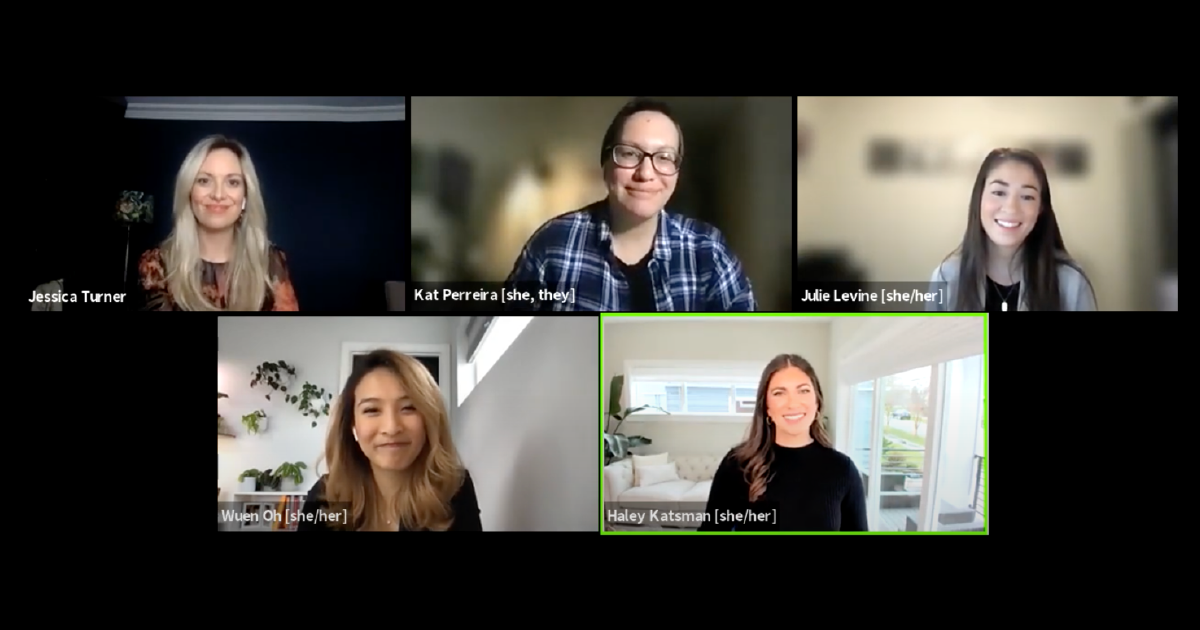Even as unprecedented numbers have joined the workforce, women have remained dramatically underrepresented in senior leadership, especially women of color. What’s more, COVID-19 has brought new roadblocks with 1 in 3 mothers considering leaving the workforce or downshifting their careers due to the pandemic.
We asked four women from across Highspot to share their experiences with challenges old and new, and offer practical tips for claiming your seat at the table with confidence. Here’s what they had to say.
Kat Perreria on Finding a Mentor
Without my mentors, I wouldn’t be as successful as I am today. I was an intern coming into tech, which feels a little like walking into a party where you only know one person — your mentor. In this analogy, my mentor can either help me feel welcome or can treat me like a burden. Luckily, my mentor was the former.
When you seek out mentors, look for someone who will actively listen and give unique guidance based on what will work best for their mentee. Find someone who will celebrate your victories and support you through difficult challenges. Above all, find someone you can trust and who you can be vulnerable with.
So how do you get a mentor? Don’t be afraid to just ask someone, but be prepared with a general idea of the goals you want to achieve and why you want to work with someone. You’d be surprised how willing people are to help.
Jessica Turner on Leveraging Business Coaches
Don’t underestimate the power of a business coach in helping you achieve your goals. To me, a business coach is someone who can help you drive a specific career outcome over a set period of time. For example, in my transition into my sales career, I paid for a sales coach to help me successfully land the first thirty, sixty, and ninety days. Internally, I also currently have sales manager coaches who I work with every day to hone specific leadership skills.
Be very specific about who you select as a business coach and keep in mind that they don’t have to be exactly like you. For example, my first sales coach at Highspot was my polar opposite, personality-wise. But that was a good thing; his strengths helped me understand and mitigate some of my weaknesses.
And be prepared to be vulnerable. You need to be honest about what you want to achieve and open about your shortcomings. Most importantly, check your ego at the door. If you aren’t open to change, you’ll be wasting your time.
Wuen Oh on Breaking the Limits
I’ve often felt boxed in based on other’s perceptions of me. It might’ve been because I’m a woman, because I’m a person of color, because I appear to be the youngest person in the room — or it could be none of the above. When I feel boxed in, I try to take these three steps: first, take an audit; second, check in with myself; and third, take up space.
In the first step, I take an audit. I ask myself the questions: What can I observe about this box that I sense I’m being placed in? Who exactly is putting me in that box? This is a crucial step because if I don’t acknowledge this thing that’s making me feel limited, it’ll have unrestricted influence over how I show up and I have very little power in changing that. The “who” question is critical because if I’ve generalized the “who” to “everyone”, then it’ll feel like a losing battle before I’ve even begun. Sometimes in reflecting on the “who”, I’ve realized it’s myself. I’m the only person telling myself “No, you can’t do this,” and that’s a special kind of battle.
In the second step, I check in with myself. Checking in with myself is a transitory step that is essential in moving from a place of feeling boxed into a place of strength and confidence. It’s during this time that I can validate my own feelings and figure out what it looks like to move forward to step three.
In the third step, I take up space. I’m constantly coaching myself to take up more space than I’m comfortable with. I grew up in between two cultures: I’m a child of refugees, born and raised in the US where all through grade school I had an “American school” context and a “Chinese school and home” context, and both of those contexts required very different things. That contrast and tension still live on today and it’s something I am cognizant of when I show up at work. My defense mechanism when I feel uncomfortable is to shrink back and even to dismiss myself from the table entirely. I find that when I choose to take up space, project confidence and advocate for myself, that’s when my career accelerates the most.
Julie Levine on the Building Confidence
A few years ago, I moved to London to help launch Highspot’s UK office. Before this role, I was most comfortable stepping back and letting the most dominant voice in the room take the lead. But, suddenly I was in a position where I had to be the leader.
One thing that was key for me in this scenario was remembering that confidence takes many forms. For me, that meant asking questions when I didn’t understand something and leveraging mentors to help remove roadblocks. I also learned to do really great sales-style discovery with my UK team to understand what was going well and what wasn’t — so when I did have time to speak with my US leaders, I knew exactly what I was going to ask.
Curiosity, asking questions, and becoming comfortable with being uncomfortable ensured I didn’t let self-doubt inhibit my progress. Though they may seem at odds, they actually helped build my confidence and allow me to thrive. Remember that confidence doesn’t mean you have to know everything; confidence can also be knowing what you don’t know — and asking for the help you need to succeed.
Claiming Your Seat at the Table with Confidence
From mentors to business coaches, to confidence-building techniques, the importance of supporting one another and finding your community inside and outside of work cannot be overstated.
Today, we encourage you all to take the opportunity to advocate for someone — whether it’s yourself, a coworker, a family member, or a friend. These small actions help us strengthen our communities during this time — and ensure we continue to make progress in building a better workplace. Tell us how you’re making the workplace more equitable on social media with the hashtag #BuildingBetter.




